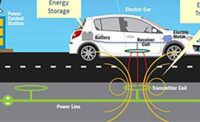This year, ASSEMBLY magazine is celebrating the 20th anniversary of its Assembly Plant of the Year award. Two facilities that received the honor in the past have successfully adopted to the electric vehicle era by investing in state-of-the-art tools and technology: Kenworth Truck Co., Renton, WA (2004 winner) and Ford Motor Co., Sterling Heights, MI (2018 winner).
Kenworth, a division of PACCAR Inc., continuously applies the latest production technology to improve the way it assembles custom-engineered, build-to-order Class 7 and Class 8 trucks. The company has developed and implemented a variety of high-tech tools and systems on the plant floor to assemble products better, faster and more efficiently than its competitors.
The Renton plant builds the widest breadth of Kenworth models used in a variety of applications, including aerodynamic long-haul vehicles such as the T680; versatile workhorse trucks like the T800 and T880; the traditional W900; and the C500, a rugged off-road model.
However, the newest model in Kenworth’s legendary lineup of heavy-duty trucks is the T680E. The battery-powered vehicle features a 396-kilowatt-hour battery and an average operating range of 150 miles, depending on application.
“Building the T680E alongside our other models required production adjustments, such as building the nonpowered unit online while installing the BEV power train offline,” says Scott Smith, plant manager. “It runs down the same main assembly line as our diesel-powered trucks. [However], the T680E has batteries in place of fuel tanks and a power control accessory unit in place of a diesel engine.”
When it received the inaugural Assembly Plant of the Year award in 2004, the facility excelled at lean production. Kenworth engineers applied Six Sigma methodology to production processes, quality control, new product introductions and transactional processes.
“[Today], Renton continues to be a leader in technology and innovation through our application of Six Sigma methodology and introduction of lean manufacturing principles guided by the PACCAR Production System,” says Smith. “Our leadership team and lean practitioners have onsite resources who teach and coach lean skills at the operator level.”
The Renton plant continues to invest in and standardize technologies that improve productivity, quality and drive zero unplanned downtime of mission-critical machines and processes.
“Through technological advancements in tooling, such as moving from air-over-hydraulic impact wrenches to DC electric tools that produce a better torqued joint, we have reduced employee noise exposure and ergonomic issue risks,” explains Smith. “To improve process capability, we have introduced automated fluid fill for the specific quantities required by each chassis, as well as electrostatic paint.
“PACCAR developed a North American materials organization that accelerated our benchmarking and adoption of best practices,” adds Smith. “For us to produce highly complex, custom-ordered vehicles with a wide variety of parts on the same assembly line with the same workforce, we implemented chassis-specific kitting at each build station.
“The kits need to be highly accurate in part selection and we use pick-to-voice and pick-to-light technologies to ensure accuracy,” notes Smith. [They ensure] just-in-time delivery of parts to the assembly line, elimination of inventory and warehousing space, allowing the plant to be focused on product assembly.”
The Renton plant has also experimented with augmented reality devices as a training tool and has introduced new technologies for monitoring equipment and systems, such as the implementation of machine health optimization sensors, PLC data and RFID tracing.
“Equipment is now monitored for potential failure using sensors to detect temperature and vibration,” says Smith. “Through analysis, the system can predict problems before they occur, which eliminates unplanned downtime and ultimately prevents catastrophic failure. We also monitor PLC data [using an integrated software platform] and have implemented RFID tags for tracking critical assets.”
Kenworth Renton uses online dashboards to deliver critical, area-specific, key process indicators to employees in real time. That ensures that safety, quality, productivity and timely resolution of assembly issues are achieved. The right information, provided at the right time, in the right way, to the right individual is the driving theme.
“To expedite tooling, assembly aides and prototyping, we also utilize in-house 3D printing to make custom assembly fixtures that help with quality and ergonomics,” says Smith.
When it received the 2018 Assembly Plant of the Year award, Ford’s Van Dyke transmission factory was mass-producing 67 different ICE transmission models to 24 North American Ford assembly plants and 13 overseas facilities. Since then, the facility has been completely transformed to make motors and transaxles for electric vehicles.
In 2021, Ford unveiled plans to rename and rebrand the 56-year-old facility the Van Dyke Electric Powertrain Center. “A longtime Michigan power train components plant now has a new name and an expanded production line that aligns with Ford’s commitment to an electric future,” proclaimed the announcement.
The facility was retooled to produce electric motors and electric transaxles for hybrid and fully electric vehicles, such as the F-150 Lightning pickup truck.
“For more than 50 years, the Van Dyke Transmission Plant has produced suspension components and traditional transmissions for [our] internal combustion engine vehicles,” said John Savona, vice president of manufacturing and labor affairs at Ford Motor Co. “In the past 10 years, the plant added hybrid transmissions to its production mix. Now, the plant is transitioning once again to support Ford’s commitment to electrification.
“The advanced technology we are using at the Van Dyke Electric Powertrain Center is taking us to the next level for Ford’s electric future,” proclaimed Savona. “The electric transformation we are making now is going to allow us to scale quickly as customer interest grows for our new electric vehicles.”
Today, the Van Dyke plant is using additive manufacturing, artificial intelligence, augmented reality, data analytics and other technology to improve quality and boost productivity.
“[Additive manufacturing] is used primarily to support spare parts in tooling,” says Mark Shkoukani, plant manager. “[For instance], if a spare ring or a gear on a machine is needed, it can be produced in-house instead of having to go to a vendor to buy.
“It also gives us flexibility to produce quick gauges or templates that can then go to vendors to produce the parts out of metal or other hard materials,” explains Shkoukani. “Plus, 3D printing gives us the added advantage of quickly testing and adjusting prototype parts. We also print kitting containers, kitting tool aids and templates for error proofing.”
Engineers at the Van Dyke Electric Powertrain Center are using AI technology to improve product quality.
“As a tool, AI can replicate, thus eliminating some destructive test sampling,” notes Shkoukani. “For example, reducing the frequency or eliminating a destructive test on an e-motor component varnish saves us both time and material. In 2022, [we] won a Ford Technical Excellence Award for [our] work in this area.”
Shkoukani and his colleagues use augmented reality technology for employee training applications. “We set up a virtual station so new operators can simulate the assembly process, learn what the job entails and get used to the environment before arriving at their future workstation,” he explains.
In addition, Ford Van Dyke engineers use data analytics every day to improve plant floor operations.
“We have a Global Data Insight & Analytics team establishing an automated dashboard to help analyze FTD and scrap data,” says Shkoukani. “Utilizing advanced control monitoring (ACM), which monitors all motions in CNC machines, enables us to improve throughput and volume by identifying wasted or redundant motions.”
Click here to learn more about the Assembly Plant of the Year award or to nominate a facility for 2024 (the deadline is May 1).




